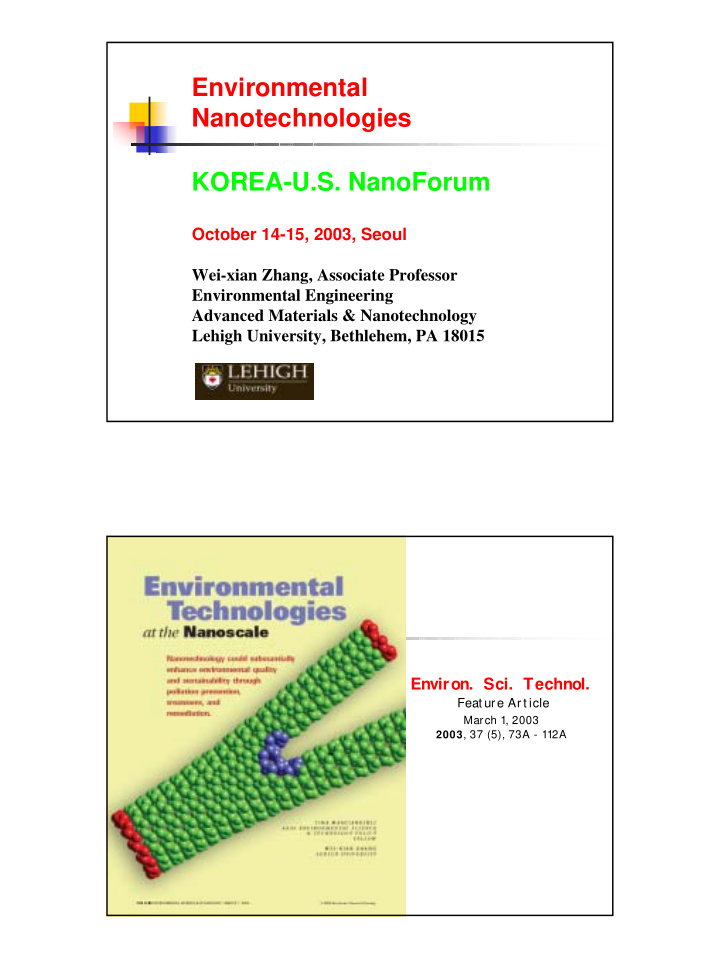



Environmental Nanotechnologies KOREA-U.S. NanoForum October 14-15, 2003, Seoul Wei-xian Zhang, Associate Professor Environmental Engineering Advanced Materials & Nanotechnology Lehigh University, Bethlehem, PA 18015 Environ. Sci. Technol. Feat ure Art icle Mar ch 1, 2003 2003 , 37 (5), 73A - 112A
Iron Nanoparticles for Treatment of Toxic Wastes J. of Nanoparticle Research 5:323-332,2003 Acknowledgments � Dr. C.B. Wang � U.S. EPA � Dr. H.(Sam) Lien � NSF � Dr. J. Cao � Dr. Daniel Elliott � PITA (PA) � Xiao-qin Li � Y.P. Sun � Steve Spear � Yu Xue � Steph Kravitz � Patrick Clasen � Tim Marks
In the 21st century we are faced with major environmental challenges … Emissions of Oil and Chemical Airborne Gaseous Spills and Part iculat e Mat t er Pest icide and Fert ilizer Runof f Abandoned I ndust rial and Mining Sit es New approaches are required t o maint ain and improve soil, wat er, and air qualit y Enter Nanotechnology … Pollut ion Prevent ion Pollut ion Prevent ion Pollut ion Prevent ion Improve environmental Improve environmental Sensors Sensors � � technologies (treatment, technologies (treatment, remediation, sensing, etc.) remediation, sensing, etc.) Improve manufacturing Improve manufacturing � � Treat ment / Treat ment / processes (efficiency, waste processes (efficiency, waste Remediat ion Remediat ion reduction, etc.) reduction, etc.) Dematerialization Dematerialization � �
Nanoscale Technologies for Pollution Prevention Make a manufacturing process environmentally benign. Be an environmentally benign material. Be a manufactured product that replaces a toxic substance or minimizes use of raw materials. Nanoscale Technologies for Sensing and Detection Biological pathogens, heavy metals, organics, etc. IBM, Zurich
Treatment/Remediation Iron Nanoparticles for Treatment of Toxic Wastes
Why Fe? � A powerful reductant � Effective for transformation of many contaminants � Widely used in environ. proc. � Accepted by regulatory agencies � Nontoxic � Cheap Why Nanoparticles? • Small size for easy subsurface injection • Extremely high reaction rate • Low temperature reaction • Added Catalytic functions
Nanoscale Bimetallic Particles C 2 Cl 4 C 2 H 6 + Cl - e - Fe 2+ , Zn 2+ Noble Metals: ~100 nm Base metal - forms galvanic cells - Electron donor - catalyze hydrogenation Base Metal Noble Metal (Pd, Pt, Ag, Ni, etc) (Fe, Zn, Al, etc) Methods of Synthesis Cluster Stabilization Reduction Formation + Precursors Fe 0 Fe 2+ , Fe 3+ CMCD (Sugar)
Size (50-60 nm) 140 120 100 Frequency 80 60 40 20 0 25 50 75 100 125 150 175 200 225 300 More Diameter (nm) Iron particles (3-5 nm)
Surface Area SSA (m 2 /g) Fe 1 mm 0.0012 (existing method) Aldrich, ~10 µm ~1.0 Lehigh (60 nm) 25-35 Lehigh (2-5 nm) 142 COSTS � Nano Iron (50 nm) � Iron Filing (~mm) � $20-50/kg � $0.5/kg � 25,000 m 2 /kg � 5 m 2 /kg � > 1,000 m 2 /dollar � < 10 m 2 /dollar
Environmental Chemistry Organic: Inorganic: Chlorinated Methanes Cr(VI) Chlorinated Ethenes Pb(II) Chlorinated Ethanes Ni(II) Chlorinated Benzenes Cu(II) PCBs Perchlorate Lindane (HCHs) As ~60 compounds tested at Lehigh TCE Reduction (C 2 HCl 3 ) - # 1 Contaminant in Groundwater (Samples from a site in NJ) 500 0.91 g/L Fe/Pd 400 TCE ( 킽 /L) 300 200 100 0 0 10 20 30 40 50 Time (hours)
Lindane (HCH) - A Pesticide ) (Sample from Jacksonville, FL) (5 g/ L Fe) Transport In Porous Media (Little has been reported) Aquifer Materials β− CD-Fe nanoparticles
Conceptual Geologic/Hydrogeologic Model Conceptual Model
Test Set-up The Nano Fe Slurry
Field Test (Nano Fe 10 kg) Total volume injected = 1,600 gallons (6,056 L) Nano Fe concentration = 1.9 g/l Average injection rate = 0.6 gpm Injection Well B-4 Monitoring Wells B-3: 20 feet north of B-4 B-2: 40 feet northeast of B-4 GW-4: 63 feet north-northeast of B-4 Monitoring
Injection Well 20 Feet Down Gradient
Summary � Reactive Fe nanoparticles for direct injection into aquifers � Enhanced reactivity (10-1,000X) � Faster cleanup time & lower costs 12 Projects � American Std � Environgen � BASF � Golder � Boeing � Geosyntec � FMC � URS � GlaxoSmithKline � GTE � Tetra Tech � Honeywell � Acadis � IBM � US Navy 10-20 tons of nanoparticles in 2004 (est.)
Keep in mind that … Nanotechnology also has the potential for harm to human health and the environment … Thanks
Recommend
More recommend